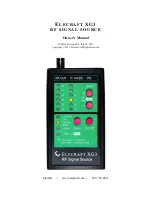
11
Programmable Morse and RTTY Sender
The XG3 contains a Morse code and RTTY sender with memory function.
The Morse code sender can be
adjusted for WPM (words per minute), and the memory can hold up to 60 characters
.
Meta-characters can
be embedded in the memory string and can be used to change the mode to RTTY, introduce pauses, turn
the carrier on or off, repeat the entire string and perform other functions. The XG3 will save the prior
output state and restore it after sending the sequence. A convenient way to enter serial commands is to use
the XG3 Utility’s Command Tester (far right tab).
For RTTY, the standard of 170 Hz FSK at 45.45 baud is implemented, with the space frequency 170 Hz
below the mark frequency. The mark frequency is the current output frequency of the XG3.
The complete set of Morse Memory meta-characters are listed below:
Morse Memory Meta-characters
{
-
turn on RTTY mode, characters following will be transmitted in RTTY
}
-
turn on CW mode, characters following will be transmitted in CW
~nn
-
send RTTY diddles (LTRS) for nn seconds (00 to 99) (RTTY only)
\n
-
send LF (RTTY only)
\r
-
send CR (RTTY only)
\b
-
send BELL
(RTTY only)
\
-
sends the character following the ‘\’ without translation. i.e. \$ or \#
[nn
-
changes wpm to nn
(05 to 50)
(CW only)
^n
-
set level to n
(0 = 0 dBm, 1 = -33, 2 = -73, 3 = -107)
:nn
-
turn carrier on for nn seconds
(00 to 99)
$nn
-
pauses for nn seconds
(00 to 99)
|nn
-
recall band/memory nn
(0 to 11)
#
-
repeat entire sequence
_
-
space
Supported Morse Characters
Letters: A-Z
Numbers: 0-9
Punctuation: . / ? @
Special: * = SK, + = AR, - = BK, _ = word space
Automatic power down is disabled during Morse memory transmission.
All serial commands must be terminated with a semi-colon ( ; ).












































